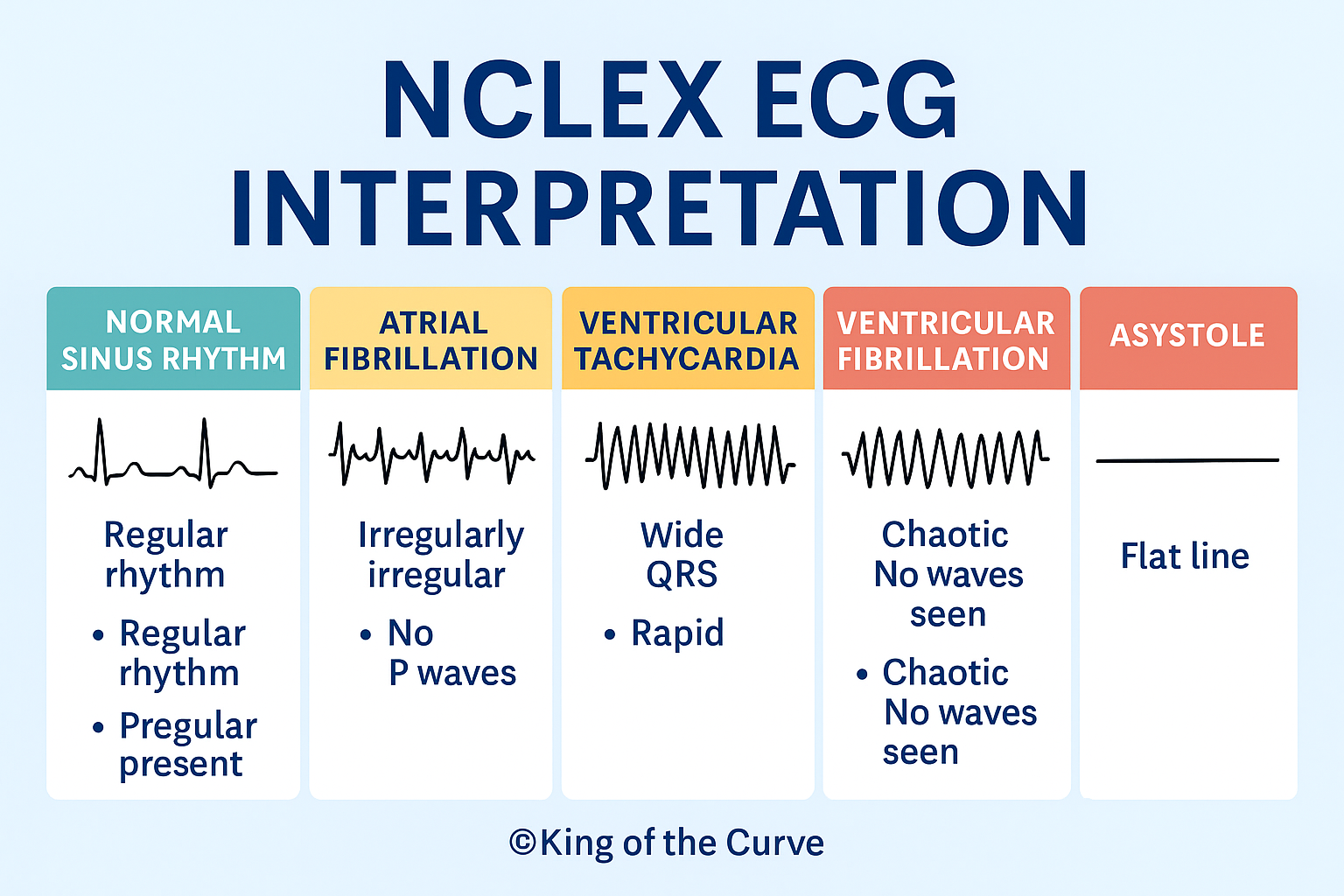🧠 NCLEX ECG Interpretation: A Nurse’s Guide to Reading EKGs
Reading ECGs doesn’t have to be scary. On the NCLEX, you don’t need to be a cardiologist—you just need to know how to recognize the rhythms that kill, understand what’s normal, and take the correct nursing action.
This guide will cover:
How to read an ECG step-by-step
High-yield rhythms for NCLEX
A KOTC visual that makes it easy
Practice questions with rationales
🧭 Step-by-Step: How to Read an ECG
Check the rate
→ Is it bradycardic, tachycardic, or normal?Assess rhythm
→ Is it regular or irregular?Examine the P wave
→ Present? Upright? 1:1 with QRS?Measure PR interval
→ Normal is 0.12–0.20 secMeasure QRS
→ Normal is 0.06–0.10 secLook at the T wave
→ Tall or inverted = possible issue
💥 High-Yield Rhythms for NCLEX
| Rhythm | Key Features | NCLEX Action |
|---|---|---|
| Sinus Bradycardia | HR < 60, regular | Assess for symptoms → Atropine if unstable |
| Atrial Fibrillation | Irregular rhythm, no P waves | Anticoagulate, control rate (BBs, CCBs) |
| Ventricular Tachycardia | Wide QRS, regular or pulseless | Pulse? → Amiodarone or defibrillation |
| Ventricular Fibrillation | Chaotic, no identifiable waves | Start CPR + defibrillate ASAP |
| Asystole | Flatline (no electrical activity) | CPR, epinephrine, DO NOT shock |
🔁 Mnemonics to Remember
"If it's fast and wide, shock it!" → V-tach, V-fib
"A-fib = no P wave, needs anticoagulation."
"Asystole is a no-shock rhythm—use Epi + CPR."
📝 Sample NCLEX Question
The telemetry monitor shows V-fib. What is the priority action?
A. Administer amiodarone
B. Perform defibrillation ✅
C. Start O₂ via nasal cannula
D. Check blood pressure
Rationale: V-fib = shockable rhythm. Defibrillate ASAP.
🧠 KOTC Study Tips
🩺 Focus on pattern recognition, not just names
📈 Practice interpreting real strips in KOTC’s ECG mode
🎯 Use visual mnemonics like our KOTC ECG strip chart
🎮 Try “Arrhythmia Blitz” in multiplayer mode to stay sharp
View more tools at kingofthecurve.org/studyscience
🧬 Before You Go…
King of the Curve is changing how students prepare for NCLEX with:
1000+ science visuals
Gamified timed challenges
Daily QOTDs with immediate feedback
An adaptive Qbank built for long-term learning
🚀 Call to Action
✅ Try the cardiac Qbank mode free → kingofthecurve.org/trial-sessions
✅ Claim your free lifetime access → kingofthecurve.org/free-lifetime
✅ Practice a strip today → kingofthecurve.org/qotd
Frequently Asked Questions (FAQs)
-
Aim for 4-6 focused hours, ensuring you incorporate breaks to avoid burnout.
-
Practice mindfulness techniques, take practice exams under realistic conditions, and maintain a balanced lifestyle.
-
Set short-term goals, seek support from mentors, and reward yourself for small achievements.
-
Regular exercise improves focus, reduces stress, and enhances overall mental clarity.
-
KOTC offers personalized learning tools, gamification features, and adaptive question banks to help students stay on track without burnout.


